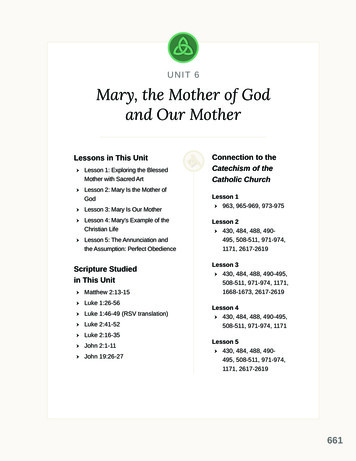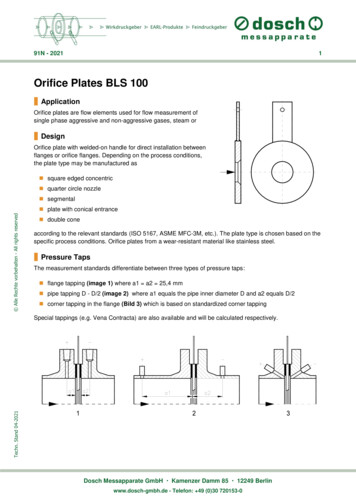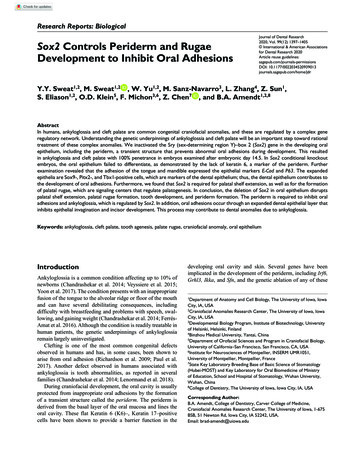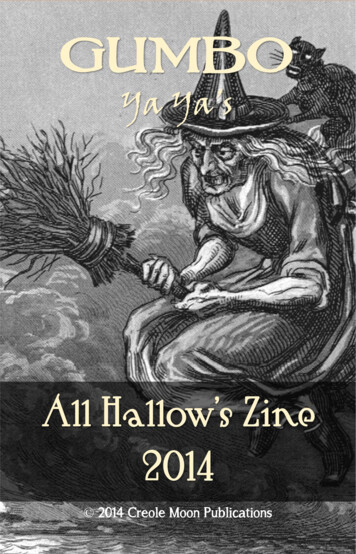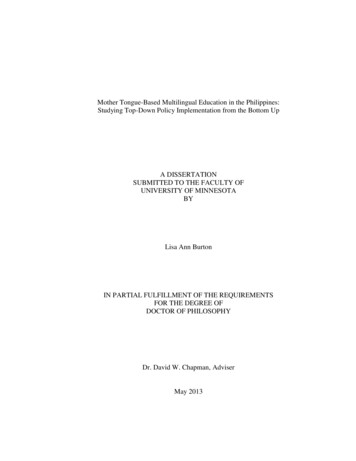
Transcription
Mother Tongue-Based Multilingual Education in the Philippines:Studying Top-Down Policy Implementation from the Bottom UpA DISSERTATIONSUBMITTED TO THE FACULTY OFUNIVERSITY OF MINNESOTABYLisa Ann BurtonIN PARTIAL FULFILLMENT OF THE REQUIREMENTSFOR THE DEGREE OFDOCTOR OF PHILOSOPHYDr. David W. Chapman, AdviserMay 2013
Lisa Ann Burton 2013
iAcknowledgementsMy journey toward a Ph.D. has come to an end. As I reflect back on the last severalyears, I am amazed by the countless learning opportunities that have occurred along theway. Each experience was enhanced by the individuals I encountered and made possibleby the support of so many others. My words cannot adequately address the contributionsof these important people in my life.My adviser, Dr. David Chapman, has been an instrumental part of my graduate schoolcareer. Having traveled together on four separate trips to Uganda and India, I had theprivilege of learning from him in the field as well as working together back home. Hechallenged me in constructive ways and served as the voice of reason on many occasions.I have grown as a person and as a researcher through my interactions with him.I am also deeply thankful for the rest of my committee members: Dr. Frances Lawrenz,Dr. David Johnson, and Dr. Chris Johnstone. Each has graciously contributed valuableinsights and feedback into my dissertation work and professional development. Dr. JoanDeJaeghere deserves special mention for the countless hours she worked with me toconceptualize my dissertation. I am continually amazed by her seemingly endless energyand desire to make a difference in this field. I am also indebted to Dr. Kendall King whohelped me see the larger picture of language policy beyond my individual study.I was blessed at the University of Minnesota to receive graduate assistantships with tworemarkable scholars and mentors: Dr. Heidi Barajas and Dr. Andrew Furco. Heidiintroduced me to the world of qualitative research and always made me feel like the mostimportant person in the world when I was with her. Andy challenged me to grow as aquantitative researcher and always emphasized that I was working with him rather thanfor him. I am thankful to have these two individuals in my corner!I have been fortunate to cross paths with many remarkable people since beginninggraduate school. I hope my work with them continues far into the future. These includeCatherine Young, Diane Dekker, Ricardo Nolasco, Carol Benson, and Kimmo Kosonenwho have all provided me valuable information about MTB-MLE. Shirley Miske andJean Strait have also played a major supporting role through their encouragement andunderstanding of the immensity of this task. In addition, many friends have offeredlistening ears and pulled me away from my computer to take needed breaks.The field work for my dissertation was made possible through the Mary CorcoranEndowed Fellowship for Evaluation and Policy Studies at the University of Minnesota.As part of that field work, I was privileged to work with three important women in thedesign and implementation of my study. Yolanda Sims graciously helped me translate mysurveys and information sheets into Tagalog prior to my data collection. Gina Pantino, aDepEd division supervisor, granted me access to schools and provided valuablebackground knowledge on MTB-MLE. Melissa Aguila, my invaluable research assistant,
iispent long hours helping me execute an ambitious research plan in a short timeframe. Icount all of these women as lifelong friends. In addition, I thank the Dela Providenciaand Dueña families who provided me a place to stay, wonderful meals, and greatconversation. I look forward to many return visits.There are several others in the Philippines who deserve credit for this dissertation,including the teachers and parents to whom I spoke and from whom I learned. Througheach conversation I learned how much they care about the students in their schools andthe children in their families. Despite the challenges presented in their lives, it is inspiringto know that their hope for the future does not fade.Most of all, I am eternally grateful for my family. In 1994, I sat at my high schoolgraduation wondering why so many thanks were being showered on the parents. As anaïve eighteen year old, I did not realize that milestones are not achieved alone but withthe support of others. My parents, Bill and Darline Mahowald, are the only people in theworld that have been with me since day one. They have never left my side, even when Ifailed to see them there. I am eternally grateful for all they have done, and I only hope Ican give to others as they have given to me.My children, Luke and Darcy, have been rays of light in this dissertation process. Theirsmiles and squeals of laughter brought immense joy to me amidst my writing, and I couldalways count on them to lighten my mood when I was starting to think too much. I countmyself lucky to have had dissertation breaks that included dance parties, wrestlingmatches, and lots of hugs. To my five year old, who has continually asked when my―book‖ would be finished, I can finally say it‘s over!I have saved the most important person in my world for last--my dear husband RobertBurton. He has given just as much as I have to make this dissertation a reality. Hisadvice, encouraging words, and gentle pushes were often the only reasons I kept working.When I was paralyzed from the fear of this task, he could somehow bring me to lifeagain. I am in awe of the patience he displayed and the sacrifices he made to allow methis opportunity. I know I could not have done this without him. It is for these reasonsthat I share the honor of this Ph.D. with him.
iiiDedicationTo my husband and best friendRobert BurtonYou are the unsung hero of this process.Others may never know the extent of your support.I will always remember.
ivAbstractThere is a growing trend around the world to support mother tongue instruction inthe early years of a child‘s education. In Southeast Asia, this is apparent in a risingnumber of educational programs that utilize this approach. However, the Philippines isthe only country in Southeast Asia to have instituted a national policy requiring mothertongue-based multilingual education (MTB-MLE) in the primary school years. Whilestudies have long supported the use of mother tongue as the language of instruction, theyhave primarily been conducted in community rather than national settings. As such, littleis known about how a national policy for MTB-MLE can be disseminated intocontextualized local environments.This study examined how teachers and parents in one school district in thePhilippines understand and enact MTB-MLE. Teachers‘ and parents‘ knowledge, beliefs,and practices were studied to identify how national language policy is appropriated at theground level. In addition, the challenges to policy implementation were explored andanalyzed. Utilizing a case study methodology, this research included focus groups,surveys, classroom observations, and individual interviews. Data were collected during athree week time period in June and July 2012, which was one month after the beginningof MTB-MLE implementation in the schools.Results from this study indicated that teachers‘ and parents‘ views of MTB-MLEfocused on the short-term benefits of the policy and the long-term disadvantages. Whileboth groups were overwhelmingly satisfied with the increase in student understanding,they expressed concern about the future implications for learning in Bikol rather than in
vEnglish. They overtly supported the policy in terms of complying with the requirements,yet covert resistance was observed in their words and actions. The implications of thesefindings revolve around the way in which language policy is managed. Rather than a topdown approach that does not consider the local context, language policy must beimplemented through interactions between the top and the bottom.
viTable of ContentsList of Tables . viiiList of Figures . ixCHAPTER I: INTRODUCTION . 1Problem Statement . 5Purpose of the Study . 7Significance of the research . 8Definitions and Terminology . 10Background: Language Policy in the Philippines . 13CHAPTER II: LITERATURE REVIEW . 20Theoretical Frameworks . 20Mother Tongue-Based Multilingual Education . 25Language Beliefs and Ideology . 30Language Management . 35Language Practices . 40CHAPTER III: METHODOLOGY . 45Research Design. 45Research Site and Participants . 47Data Collection . 52Data Analysis . 59Quality Criteria . 62Limitations . 64CHAPTER IV: RESULTS. 67Research Question #1 . 67Research Question #2 . 73Research Question #3 . 84Research Question #4 . 90
viiCHAPTER V: DISCUSSION AND CONCLUSIONS . 99Summary of the results . 99Discussion of key findings . 102Theoretical Implications . 112Practical Implications. 115Future Research . 117Conclusion . 118REFERENCES . 122APPENDICESAppendix A: Map of the Philippines . 135Appendix B: Teacher Focus Group Protocol . 136Appendix C: Parent Focus Group Protocol . 138Appendix D: Teacher Survey (English) . 140Appendix E: Teacher Survey (Tagalog) . 143Appendix F: Parent Survey (English) . 147Appendix G: Parent Survey (Tagaog). 150Appendix H: Classroom Observation Protocol. 153Appendix I: Teacher Interview Protocol. 154Appendix J: Parent Interview Protocol . 155Appendix K: Study Information Sheet (English). 156Appendix L: Study Information Sheet (Tagalog) . 157
viiiList of TablesTable 1. School demographics . 48Table 2. Teacher focus group sample sizes (n) . 50Table 3. Teacher survey sample sizes (n) . 50Table 4. Parent Focus Group Sample Sizes (n) . 51Table 5. Parent Survey Sample Sizes (n) . 51Table 6. Teachers' and parents' knowledge of MTB-MLE policy . 68Table 7. Teachers' and parents' views on the importance of culturally relevant lessons . 70Table 8. Tachers‘ and parents‘ beliefs about content-based understanding . 74Table 9. Teachers‘ and parents‘ beliefs about effects of Bikol literacy. 79Table 10. Teachers' and parents' views about importance of Bikol for instruction . 80Table 11. Teachers‘ and parents‘ beliefs about language of instruction . 80Table 12. Teachers' and parents' views on the importance of Bikol literacy . 84Table 13. Teachers' and parents' views on the importance of parent involvement . 87Table 14. Teachers' perceptions of classroom implementation . 91
ixList of FiguresFigure 1. Spolsky's Language Policy Components . 22Figure 2. Ricento and Hornberger's Language Planning and Policy Model . 24Figure 3. Proposed language policy model . 113
1CHAPTER IIntroductionThe linguistic and cultural diversity in the Philippines brings much complexity tothe issue of language policy in education. With more than 7000 islands and 181 distinctlanguages (Lewis, Simons, & Fennig, 2013), the Philippines offers a challengingenvironment for implementing a language policy that can serve the whole country.Consequently, language policies for Philippines‘ schools have fluctuated greatly over thelast century with a different policy for nearly every generation. Until recently, the 1974and 1987 Bilingual Education Policies determined the language of instruction in schoolsto be Filipino and English. This is despite the fact that about 80% of the population doesnot speak either of these as a first language.In 2009, the Department of Education (DepEd) challenged the BilingualEducation Policy by issuing an order that called for institutionalization of mother tonguebased multilingual education (MTB-MLE). This order requires use of the learners‘ firstlanguage as the medium of instruction for all subject areas in pre-kindergarten throughgrade three with Filipino and English being taught as separate subjects (PhilippinesDepartment of Education, 2009). Another order was issued in 2012 that offered morespecific guidelines for MTB-MLE and embedded the reform in the newly adopted ―K to12 Basic Education Program‖ (Philippines Department of Education, 2012). This ordershifted from the original mother tongue approach by specifying twelve major regionallanguages to be used as the languages of instruction. Under this order, teachers are
2provided government-issued materials in their regional languages but are expected toadapt them to reflect the students‘ first languages.Until recently, the MTB-MLE policy resided solely within DepEd. However, inJanuary 2013 the Philippines‘ Congress officially supported this effort by passing theEnhanced Basic Education Act. In addition to shifting toward a K-12 educationalstructure, this legislation requires instruction, teaching materials, and assessments to be inthe ―regional or native language of the learners‖ from kindergarten through grade threewith a ―mother language transition program‖ from grades four through six. Despite thefact that President Benigno Aquino has not yet signed the bill into law, nation-wideimplementation of MTB-MLE has begun. Gradual implementation started with grade onestudents in 2012 and will be followed by grades two and three in 2013 and 2014respectively.This shift in language policy is part of a growing trend around the world tosupport mother tongue instruction in the early years of a child‘s education. In SoutheastAsia, this is apparent in a rising number of educational programs that utilize a mothertongue approach. Examples can be found in Cambodia, Indonesia, Malaysia, Thailand,Timor L‘Este and Vietnam (Kosonen, in press; Kosonen & Young, 2009; Taylor-Leech,2013; UNESCO, 2007). In all of these cases, the programs are being piloted at thecommunity level with support from international non-governmental agencies (INGOs).While the use of non-dominant languages in education is allowed in each of thesecountries, the Philippines is the single country to institute a national policy requiring theirinclusion in the early grades. As a result, the implementation of MTB-MLE in thePhilippines is being looked at as an example for the rest of the region.
3The move by DepEd and Congress to adopt MTB-MLE was based on theoutcomes of previous quantitative, longitudinal studies that highlighted the benefits ofusing the mother tongue as the language of instruction. Two studies in the United States(Ramirez, Yuen, & Ramey, 1991; Thomas & Collier, 1997) and one in the Philippines(Walter & Dekker, 2011) concluded that minority language students who gained literacyin their first language experienced higher academic achievement than students wholearned in a second or third language. They suggested that second and third languagescan be acquired more easily if a foundation in the first language is established early.1 Inaddition, these studies pointed to the importance of late-exit programs in which themother tongue is utilized until grade six with other languages taught as separate subjects.These findings are apparent in DepEd‘s policy statements about the objectivesand outcomes of the MTBE-MLE reform. Three outcomes cited in the 2009 orderfocused on the speed in which students will gain literacy skills under the MTB-MLEreform:1) Learners learn to read more quickly when in their first language (L1);2) Pupils who have learned to read and write in their first language learn to speak,read, and write in a second language (L2) and third language (L3) more quicklythan those who are taught in a second or third language first; and3) In terms of cognitive development and its effects on other academic areas, pupilstaught to read and write in their first language acquire such competencies morequickly (Philippines Department of Education, 2009, p. 1).1This is the case for language minority students who have limited exposure to their mother tongue in theoutside environment. The literature suggests language majority students can learn in a minority languageand still gain literacy in their mother tongue due to the availability of majority language resources insociety (Cummins, 1981; Cummins & Swain, 1986; Johnson & Swain, 1997).
4The 2012 order included objectives that more broadly emphasized the influence of MTBMLE on four areas of development:1) Language development which establishes a strong education for success in schooland for lifelong learning;2) Cognitive development which focuses on Higher Order Thinking Skills (HOTS);3) Academic development which prepares the learner to acquire mastery ofcompetencies in each of the learning areas; and4) Socio-cultural awareness which enhances the pride of the learner‘s heritage,language and culture (Philippines Department of Education, 2012, p. 3).While the DepEd orders called for the learners‘ first language to be phased out aftergrade three (i.e., early-exit model), Congress supported a late-exit model that allowed fora transition period from grades four through six. The late-exit model aligns with pastresearch but has not yet been discussed in terms of logistics.The ideological and implementational spaces (Hornberger, 2002) for MTB-MLEappear to be opening at the national level in the Philippines through the support of DepEdand Congress. However, less attention has been given to the perspectives of those at thecommunity level where implementation will actually occur. Teachers and parents are twokey stakeholder groups that are often forgotten in the policy process despite the fact thatthey hold much power for carrying out a reform (Fullan, 2003; Shohamy, 2006).Examination of the ideological and implementational spaces at the ground level must beconsidered in addition to those at the national level. These perspectives about MTB-MLEare necessary for successful implementation of the reform.
5Problem StatementThe DepEd MTB-MLE policy objectives and expected outcomes arecomprehensive and based on research, but the challenge arises in implementation. Asnoted above, mother tongue education initiatives in Southeast Asia have been primarilyimplemented through community-based pilot programs. Similarly, this is true in othercountries around the world where students‘ first languages are utilized in classrooms aspart of small-scale efforts rather than national reforms (e.g., Cameroon, India, Mali,Nepal, Papau New Guinea). A few countries have attempted to implement nationalmultilingual education policies but have struggled with the enormity of the task (e.g.,Bolivia, Ethiopia, Peru, South Africa). Scholars argue that top-down approaches do notconsider the contextualized nature of language in communities (Kaplan, 1990; MartinJones & Saxena, 1995; Ricento & Hornberger, 1996). Therefore, implementation ofMTB-MLE in the Philippines is questioned for its feasibility as a national approach. It isunclear whether the academic outcomes identified in the research will be extended to topdown policy scenarios.One faulty assumption of top-down policy approaches is that the mandate will befollowed simply because the order was issued. This belief was apparent in a conversationwith a DepEd supervisor in February 2010 during a visit to the Philippines for predissertation research. When the supervisor was asked whether teachers and parents wouldsupport the new reform, she responded with a surprised voice, ―Of course. They will justdo it. It‘s an order.‖ The centralized system in the Philippines has fostered strong powerdifferentials between local stakeholders and government officials. This has created
6assumptions from those at the top that individuals at the bottom will comply withoutquestion.While top-down policy approaches hold the potential for large-scale change,Matland (1995) suggested that they should be reserved for policies with low ambiguityand low conflict. Policies with low ambiguity are easy to interpret, and policies with lowconflict have little chance of creating resistance for implementation. Matland compared apolicy of this nature with a machine in which explicit information flows from one level tothe next. He argued that top-down approaches are best suited for policies that aretechnical and administrative in nature. They must essentially be assured to succeed aslong as the appropriate resources are allocated.Counter to Matland‘s (1995) guidelines, the MTB-MLE reform in the Philippinescontains high ambiguity and high conflict. In terms of ambiguity, the DepEd ordersspecified what should be done but offered little support for how it should be done. Forexample, the orders called for instruction in the mother tongue, yet government-providedresources are only available in the twelve primary regional languages. As such, it isunclear how to implement the policy in a way that aligns with the desired mother tongueapproach given the lack of suitable materials.In terms of conflict, language is inherently a sensitive issue ripe with tension.This is particularly the case in today‘s world where English is a globalizing force that isassociated with power and economic growth. Previous studies have pointed to thechallenge encountered when mother tongue education programs confront local ideologiesfavoring English (e.g., Iyamu & Ogiegbaen, 2007). This stands in contrast to the goals ofMTB-MLE and creates potential for conflict to arise over its implementation.
7Policies with high ambiguity and high conflict may require more involvementfrom the ground level to be sustainable and effective (Darling-Hammond, 1990; Elmore,1983; Matland, 1995). In the case of MTB-MLE, very little consideration has been givento the perspectives of those at the ground level, namely teachers and parents. Rather, theyare more frequently viewed as ―‗soldiers‘ of the system‖ carrying out the orders given tothem (Shohamy, 2006). Despite assumptions that the reform is being implemented inalignment with explicit policy statements, previous research has suggested that policiesare interpreted and appropriated differently depending on the context (Johnson &Freeman, 2010; McCarty, 2011). While the national MTB-MLE policy statement (i.e.,the de jure policy) aims to integrate mother tongue instruction throughout the country, theactual implementation (i.e., the de facto policy) likely differs across communities. Thispoints to the importance of teachers and parents in the policy process because, in essence,their actions are the policy (Sutton & Levinson, 2001). Counter to the claim made aboveby the DepEd supervisor, they may not ―just do it‖ when it comes to implementation.Purpose of the StudyThis study examined the ways in which teachers and parents understand and enactMTB-MLE in one school district in the Philippines. It provides a comparative look at thedifferences between teachers‘ and parents‘ knowledge, beliefs, and practices at the locallevel and frames them in the context of the national policy statements. This researchaddresses the calls in the literature to provide local perspectives on language policy(Shohamy, 2006; Ricento & Hornberger, 1996), which are frequently absent fromdiscussions on this topic. While the findings cannot be generalized to other contexts, theyprovide a revealing look at the experiences with this policy in one school district and may
8inform language policy development and practices in other circumstances. The followingresearch questions will be addressed in this study:1. What do teachers and parents know about MTB-MLE? To what extent does theirknowledge differ?2. What do teachers and parents believe about the outcomes of MTB-MLE? To whatextent do their beliefs differ?3. How do teachers and parents demonstrate support and resistance for MTB-MLE?In what ways do their actions differ?4. What challenges exist related to implementation of MTB-MLE?Significance of the researchThis study fills both theoretical and practical gaps around MTB-MLE policy. Itaddresses theory by directing the focus of the analysis to the bottom-up perspective ofteachers and parents amidst the national top-down reform. Language policy theorysuggests that language management occurs when external forces make decisions for thoseat the ground level (Spolsky, 2004, 2011), but there is a need to understand how languagemanagement might occur from the bottom up. While a growing number of scholars haverecognized the importance of involving local stakeholders in the language policy process(Shohamy, 2006; McCarty, 2011; Mohanty, Panda, & Pal, 2010; Ricento & Hornberger,1996), relatively few studies have examined language policy from the perspective ofthose in the community. Analyses of explicit policy statements do not yield accuraterepresentations of how policy is being carried out on the ground.Previous studies have included teachers‘ or parents‘ attitudes toward language orparticular language policies (Iyamu & Ogiegbaen, 2007; Silver & Skuja-Steele, 2005).
9These are important for understanding local stakeholders‘ perspective of a nationalreform and can help guide policy development. Even more significant is the growingnumber of studies that have focused on teachers‘ agency in language policyimplementation (see Menken & García, 2010). This moves beyond the mentality ofpolicy as something that is done to people but points to the power of those at the groundlevel to make change. Ironically, many of these studies have focused on teachers‘resistance to language policies that prohibit using local languages in the classroom infavor of national or world languages. The current study differs b
This study examined how teachers and parents in one school district in the Philippines understand and enact MTB-MLE. Teachers‘ and parents‘ knowledge, beliefs, and practices were studied to identify how national language policy is appropriated at the ground level. In addition, the challe
